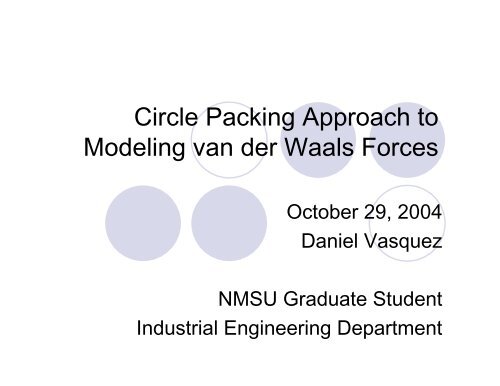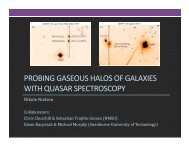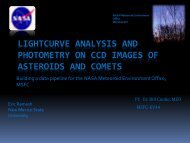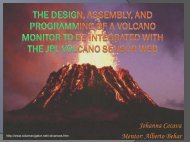Circle Packing Approach to Modeling van der Waals Forces
Circle Packing Approach to Modeling van der Waals Forces
Circle Packing Approach to Modeling van der Waals Forces
You also want an ePaper? Increase the reach of your titles
YUMPU automatically turns print PDFs into web optimized ePapers that Google loves.
<strong>Circle</strong> <strong>Packing</strong> <strong>Approach</strong> <strong>to</strong><br />
<strong>Modeling</strong> <strong>van</strong> <strong>der</strong> <strong>Waals</strong> <strong>Forces</strong><br />
Oc<strong>to</strong>ber 29, 2004<br />
Daniel Vasquez<br />
NMSU Graduate Student<br />
Industrial Engineering Department
<strong>Circle</strong> <strong>Packing</strong> <strong>Approach</strong> <strong>to</strong><br />
<strong>Modeling</strong> <strong>van</strong> <strong>der</strong> <strong>Waals</strong> <strong>Forces</strong><br />
�Introduction<br />
�Microassembly.<br />
�Adhesive <strong>Forces</strong>.<br />
�Van <strong>der</strong> <strong>Waals</strong> <strong>Forces</strong><br />
�Research Objective<br />
�Geometric modeling of a cylindrical part<br />
using <strong>Circle</strong> <strong>Packing</strong><br />
�Results<br />
�Conclusions & Future Directions
Introduction<br />
�Microassembly<br />
�Process of manipulating micro-components (10 -6 m) <strong>to</strong><br />
build a micro-structures.<br />
�Adhesive <strong>Forces</strong><br />
�<strong>Forces</strong> that at the micro level cause “sticking” of<br />
components <strong>to</strong> manipula<strong>to</strong>rs.<br />
�Surface Tension, Electrostatic, and <strong>van</strong> <strong>der</strong> <strong>Waals</strong><br />
[3][4].<br />
�Van <strong>der</strong> <strong>Waals</strong> (vdW)<br />
�Adhesive force caused by a induced dipole<br />
polarization between a<strong>to</strong>ms, and molecules [2].
Introduction<br />
�Van <strong>der</strong> <strong>Waals</strong> (vdW).<br />
�Closed form solutions of vdW interactions between<br />
different geometries are ideal and limited.<br />
D<br />
y<br />
z<br />
x<br />
Ad<br />
Fvdw = 2<br />
12z<br />
[1]<br />
Figure I. Van <strong>der</strong> <strong>Waals</strong> force interaction between a sphere and a flat plane, and a cylin<strong>der</strong> and a flat plate.<br />
A is the Hamaker constant. *www.clarkson.edu/projects/fluidflow/courses/me537/5_<strong>van</strong><strong>der</strong><strong>Waals</strong>.pdf<br />
D<br />
y<br />
z x<br />
Fvdw =<br />
lenght<br />
1<br />
2<br />
Ad<br />
16z<br />
2<br />
*
Research Objective<br />
�Develop a finite method of modeling <strong>van</strong><br />
vdW forces.<br />
�Depart from closed form solutions, that only<br />
model ideal shapes.<br />
�Model geometries of greater complexity.<br />
�Initial model, cylin<strong>der</strong>-flat plane interaction.<br />
�Use closed form solution sphere-plane as finite<br />
element.<br />
�Why? To predict and plan for vdW<br />
interactions during assembly planning.
Geometric <strong>Modeling</strong> of a Cylindrical<br />
Part using <strong>Circle</strong> <strong>Packing</strong><br />
�1. <strong>Circle</strong> <strong>Packing</strong>- mathematical modeling<br />
of packing circles in<strong>to</strong> circles.<br />
� Provides a cross sectional template for cylin<strong>der</strong>.<br />
� Defines the coordinates (x i , y i ) of individual circles i .<br />
y<br />
x<br />
Figure II. <strong>Circle</strong> <strong>Packing</strong> Model
Geometric <strong>Modeling</strong> of a Cylindrical<br />
Part using <strong>Circle</strong> <strong>Packing</strong><br />
� 2. Pack spheres in circular packing model, and sum the<br />
individual sphere interactions f i relative <strong>to</strong> a planar<br />
surface at some distance (Figure III).<br />
D<br />
y<br />
d<br />
F vdW<br />
Figure III. Summation of sphere <strong>to</strong> flat plane <strong>van</strong> <strong>der</strong> <strong>Waals</strong> force interactions..<br />
x<br />
F<br />
vdW<br />
≈<br />
n<br />
∑<br />
i=<br />
1<br />
f<br />
i
Geometric <strong>Modeling</strong> of a Cylindrical<br />
Part using <strong>Circle</strong> <strong>Packing</strong><br />
� 3. Circular pattern represents a thin disk of depth d, <strong>to</strong>tal<br />
<strong>van</strong> <strong>der</strong> <strong>Waals</strong> interaction is approximately F vdW .<br />
� 4. Define a cylindrical part of length L, where L can be<br />
some multiple of d. L = n*d. Solve for n.<br />
D<br />
F vdwcyl = n * F vdW<br />
x<br />
d d<br />
d<br />
L<br />
L = n * d<br />
Figure IV. Summation of sphere <strong>to</strong> flat plane <strong>van</strong> <strong>der</strong> <strong>Waals</strong> force interactions..<br />
d<br />
d
Geometric <strong>Modeling</strong> of a Cylindrical<br />
Part using <strong>Circle</strong> <strong>Packing</strong><br />
�5. F vdwcyl = n*F vdw<br />
�6. Compare result <strong>to</strong> reference model (Figure V).<br />
y<br />
D<br />
z x<br />
Fvdw =<br />
lenght<br />
�7. Pack more spheres in<strong>to</strong> cross section <strong>to</strong> obtain an<br />
optimal solution and then repeat steps 1 – 6.<br />
1<br />
2<br />
Ad<br />
16z<br />
Figure V. Van <strong>der</strong> <strong>Waals</strong> model of cylin<strong>der</strong>-flat plane.<br />
2
Results<br />
<strong>van</strong> <strong>der</strong> <strong>Waals</strong><br />
100<br />
10<br />
1<br />
0.1<br />
0.01<br />
0.001<br />
0.0001<br />
Packed Cylin<strong>der</strong> Models<br />
1 2 3 4 5 6 7 8 9 10<br />
Distance Z from Flat Plane<br />
N = 7<br />
N = 61<br />
N = 100<br />
N = 150<br />
N = 200<br />
N = 250<br />
N = 300<br />
N = 350<br />
N = 400<br />
N = 450<br />
N = 500<br />
Reference Model<br />
Figure VI. Van <strong>der</strong> <strong>Waals</strong> “sphere packed” finite model of cylin<strong>der</strong>-flat plane compared <strong>to</strong> reference model, where N<br />
represents the number of spheres packed in<strong>to</strong> a given cross-section.<br />
y<br />
x
Conclusions & Future Direction:<br />
1. Optimal sphere packing solution shows<br />
variation when compared <strong>to</strong> reference model.<br />
At best optimal solution only approximates<br />
reference model.<br />
2. Future: model other <strong>van</strong> <strong>der</strong> <strong>Waals</strong> models<br />
such as sphere <strong>to</strong> sphere interactions using<br />
sphere packing . Desirable <strong>to</strong> establish a<br />
comparison <strong>to</strong> other known <strong>van</strong> <strong>der</strong> <strong>Waals</strong><br />
solutions.
References<br />
� [1] Israelachvili, Jacob. Intermolecular Surface <strong>Forces</strong>. 2nd ed. New<br />
York: Academic Press, 1992.<br />
� [2] Kitchener, J.A. “Surface <strong>Forces</strong> in the Deposition of Small<br />
Particles.” Journal of the Society of Cosmetic Chemists. Vol. 24<br />
(1973): 709-725.<br />
� [3] Bowling, R. Allen. “Theoretical Review of Particle Adhesion.”<br />
Particles on Surfaces I. K. L. Mittal, edi<strong>to</strong>r, (1988) 129-142.<br />
� [4] Elimelech, M., J. Gregory, X. Jia, and R. A. Williams. Particle<br />
Deposition and Aggregation: Measurement, <strong>Modeling</strong>, and<br />
Simulation. Butterworth-Heinemann Ltd, 1995. pgs 42-50.<br />
� [5] The best known packings of equal circles in the unit circle (up <strong>to</strong><br />
N = 500) http://hydra.nat.uni-magdeburg.de/packing/cci/cci.html
Acknowledgements<br />
� Dr. J. Cecil. NMSU Industrial Engineering Department: Virtual<br />
Engineering Enterprise Lab.<br />
� James F. (Red) Jones. Sandia National Labora<strong>to</strong>ries: System<br />
Technologies.









